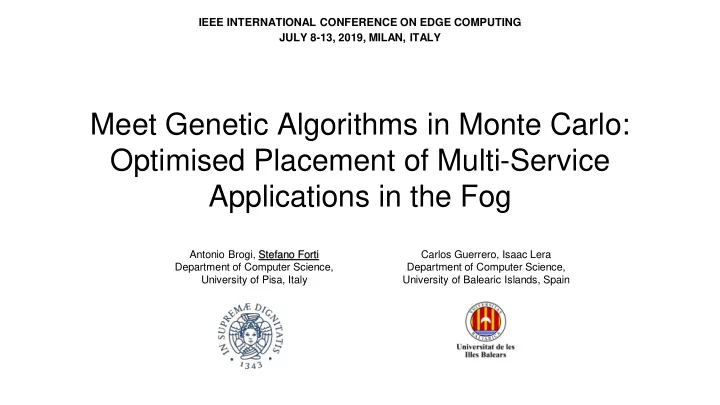

IEEE INTERNATIONAL CONFERENCE ON EDGE COMPUTING JULY 8-13, 2019, MILAN, ITALY Meet Genetic Algorithms in Monte Carlo: Optimised Placement of Multi-Service Applications in the Fog Antonio Brogi, Stefano Forti Carlos Guerrero, Isaac Lera Department of Computer Science, Department of Computer Science, University of Pisa, Italy University of Balearic Islands, Spain
CONTINUOUS IOT GROWTH Drones for Energy Smart Cities Embedded AI Autonomous deliveries production driving 2
LARGE HIGHLY DISTRIBUTED SOFTWARE SYSTEMS multi-component osmotic microservices 3
PERVASIVELY DISTRIBUTED INFRASTRUCTURES cloud micro-cloud fog edge mist IoT 4
STRINGENT QoS REQUIREMENTS 5
How to deploy (and re-deploy) LARGE HIGHLY DISTRIBUTED SOFTWARE SYSTEMS to PERVASIVELY DISTRIBUTED INFRASTRUCTURES so so to to guarantee their STRINGENT QoS REQUIREMENTS ? 6
It’s NP-hard! 7
Research Question Which is the best deployment (i.e. placement)? Much work has been done in this field* but mostly focussing on single application deployment. We target simultaneous deployment of multiple microservice-based applications. * A. Brogi, S. Forti, C. Guerrero, I. Lera. "How to Place Your Apps in the Fog-State of the Art and Open Challenges." arXiv:1901.05717 (2019). 8
Previously … Monte Carlo Genetic Algorithms QoS-, cost- and context-aware (Meta-)heuristic approach for ranking application deployments, considering eligible deployments as solutions to network QoS variations multi-objective optimisation problems. Brogi et al., How to best deploy your Fog applications, probably. Guerrero et al., Genetic algorithm for multi-objective optimization of container ICFEC17, Madrid, 2017 allocation in cloud architecture . Journal of Grid Computing, 2018.
FogTorch Π (Monte Carlo) Predictive Analysis to Support Fog Application Deployment Fog and Edge Computing: Principles and Paradigms, Wiley, 2019. ☺ Can assess eligible deployments against varying infrastructures Shows exp-time complexity ( 𝑷 𝑶𝒑𝒆𝒇𝒕 |𝑻𝒇𝒔𝒘𝒋𝒅𝒇𝒕|
Genetic Algorithms Deployments as chromosomes (i.e. services → nodes) 0) Initial random population 1) Fitness function & Selection 2) Cross-over 3) Mutation 𝟏. 𝟗 𝟏. 𝟑 𝟏. 𝟘 ☺ Very fast convergence in practice Does not consider infrastructure variations
Objective ☺ Assess eligible deployments against varying infrastructures ☺ Very fast convergence in practice ? + = Can we have our cake and eat it too?
Fitness Function Given a bag of deployments 𝐸 (one per application), over a state of a Fog infrastructure 𝐽’: ● maximise QoS-assurance ● minimise Fog resource consumption ● minimise monthly deployment costs
MC+GA 1. Find two (Pareto-optimal) solution deployments sets – 𝐸 𝑐𝑓𝑡𝑢 and 𝐸 𝑥𝑝𝑠𝑡𝑢 – by using GA in the best and worst infrastructure conditions, and 2. Assess 𝐸 𝑐𝑓𝑡𝑢 and 𝐸 𝑥𝑝𝑠𝑡𝑢 by using Monte Carlo simulations to make infrastructure conditions vary in all possible ways. We implemented and open-sourced this combo in FogTorch Π ! https://github.com/di-unipi-socc/FogTorchPI/tree/genetic-algs
Experimental evaluation Example application (4 services)
Experimental evaluation (1) On two infrastructures: - SMALL SCALE (5 nodes + 2 apps)
Results (Small-Scale) 24 sol.s 26,623 sol.s
Experimental evaluation (2) On two infrastructures: - SMALL SCALE (5 nodes, 2 apps) - LARGE SCALE (200 nodes, 10 apps) x10 A. Medina, A. Lakhina, I. Matta, and J. Byers, “ BRITE: an approach to universal topology generation, ” in MASCOTS 2001, , pp. 346 – 353. > Barabasi- Albert Model
Results (Large-Scale)
Analysis PERFORMANCE Small-Scale Large-Scale Exhaustive Search 67s - Genetic Algorithm 1.5s 40s Number of SOLUTIONS Small-Scale Large-Scale Exhaustive Search 26623 - Genetic Algorithm 24 37
Objective ☺ Assess eligible deployments against varying infrastructures ☺ Very fast convergence in practice ? + = Can we have our cake and eat it too?
Concluding Remarks Our MC+GA approach showed substantial performance improvements with respect to exhaustive search. Indeed, it finds the best candidate deployment solutions in a significantly lower execution time ( 40x on a small-scale experiment), and shows better scalability over large problem instances. Future Work - Include more sophisticated GAs and compare their performance - Assess predictions against actual application deployments.
Thank you for your attention. Questions? Acknowledgments : ● This work was partly supported by the project “DECLWARE” ( PRA201866 ) funded by the University of Pisa. ● Spanish Government (“Agencia Estatal de Investigación”) and the European Commission (“Fondo Europeo de Desarrollo Regional”) through grant number TIN2017-88547-P (MINECO/AEI/FEDER, UE). References : ● A. Brogi and S. Forti, “QoS - aware deployment of IoT applications through the fog,” IEEE Internet of Things Journal. vol. 4, no. 5, pp. 1185 – 1192, 2017. ● C. Guerrero, I. Lera, I. and C. Juiz. “Genetic algorithm for multi -objective optimization of container allocation in cloud archi tecture”. Journal of Grid Computing, 16(1): 113--135, Springer, 2018. Antonio Brogi, Stefano Forti Carlos Guerrero, Isaac Lera Department of Computer Science, Department of Computer Science, University of Pisa, Italy University of Balearic Islands, Spain
Recommend
More recommend